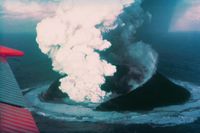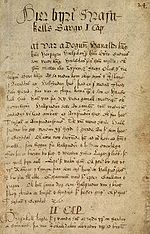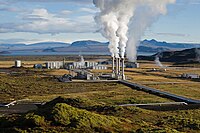Portal:Iceland/Selected article
| This Wikipedia page has been superseded by Portal:Iceland and is retained primarily for historical reference. |
| Note: Article entries are now being transcluded directly on the main portal page. However, this page should be retained for historical reference. |
Usage
The layout used to format these sub-pages is at {{selected article}}
- Add a new selected article to the next available subpage.
- Update "max=" to new total for its {{Random portal component}} on the main page.
Selected article 1
Portal:Iceland/Selected article/1
Surtsey (Icelandic: "Surtur's island") is a volcanic island off the southern coast of Iceland. At 63°18′N 20°37′W / 63.30°N 20.62°W it is also the southernmost point of Iceland. It was formed in a volcanic eruption which began 130 metres below sea level, and reached the surface on 14 November 1963. The eruption may have started a few days earlier and lasted until 5 June 1967, when the island reached its maximum size of 2.7 km². Since then, wind and wave erosion has seen the island steadily diminish in size: as of 2005[update] it is only 1.4 km² in size.The new island was named after the fire giant Surtur from Norse mythology, and was intensively studied by volcanologists during its creation and, since the end of the eruption, has been of great interest to botanists and biologists as life has gradually colonised the originally barren island. The undersea vents that produced Surtsey are part of the Vestmannaeyjar (Westmann Isles) submarine volcanic system, part of the fissure of the sea floor called the Mid-Atlantic Ridge. Vestmannaeyjar also produced the famous eruption of Eldfell on the island of Heimaey in 1973. The eruption that created Surtsey also created a few other small islands along this volcanic chain, such as Jólnir and other unnamed peaks. Most of these eroded away fairly quickly.
Selected article 2
Portal:Iceland/Selected article/2
Reykjavík is the capital of Iceland, its largest city, and the world's most northern national capital (its latitude being 64°08' N, not far from the Arctic Circle). It receives only four hours of daylight per day in the depth of winter, and during the summer the nights are almost as bright as the days.Reykjavík is located in southwest Iceland at the shores of Faxaflói bay. The Reykjavík area coastline is characterized by peninsulas, coves, straits and islands. The population of Reykjavík in 2005 was 114,800, the combined population of the Capital Region being about 190,000.
The first permanent settlement in Iceland by Nordic people is believed to have been established in Reykjavík by Ingólfur Arnarson around AD 870; this is described in Landnámabók, or the Book of Settlement. Ingólfur Arnarson is said to have decided the location of his settlement using a traditional Viking method; by dumping his high seat pillars, Öndvegissúlur, in the ocean when he saw the coastline and then settled where the pillars came to shore. Steam from hot springs in the region is supposed to have inspired Reykjavík's name, as Reykjavík translates to "Bay of Smokes".
Selected article 3
Portal:Iceland/Selected article/3
The Althing is the national parliament: literally, the "all-thing" of Iceland. It was founded in 930 at Þingvellir, (the "assembly fields" or "Parliament Plains"), situated some 45 km east of what would later become the country's capital, Reykjavík, and this event marked the beginning of the Icelandic Commonwealth. Even after Iceland's union with Norway, the Althing still held its sessions at Þingvellir until 1799, when it was discontinued for some decades. It was restored in 1844 and moved to Reykjavík, where it has resided ever since. The present parliament building, the Alþingishús, was built in 1881, of hewn Icelandic stone.The constitution of Iceland provides for six electoral constituencies with the possibility of an increase to seven. The constituency boundaries are fixed by legislation. Each constituency elects nine members. In addition, each party is allocated seats based on its proportion of the overall national vote in order that the number of members in parliament for each political party should be more or less proportional to its overall electoral support. A party must have won at least five percent of the national vote in order to be eligible for these proportionally distributed seats. Political participation in Iceland is very high: usually over 85 per cent of the electorate casts a ballot (87.7% in 2003). The current president of the Althing is Sólveig Pétursdóttir.
Selected article 4
Portal:Iceland/Selected article/4
Hrafnkels saga is one of the Icelanders' sagas. It tells of struggles between chieftains and farmers in the east of Iceland in the 10th century. The eponymous main character, Hrafnkell, starts out his career as a fearsome duellist and a dedicated worshiper of the god Freyr. After suffering defeat, humiliation, and the destruction of his temple, he becomes an atheist. His character changes and he becomes more peaceful in dealing with others. After gradually rebuilding his power base for several years, he achieves revenge against his enemies and lives out the rest of his life as a powerful and respected chieftain.The saga has been interpreted as the story of a man who arrives at the conclusion that the true basis of power does not lie in the favor of the gods but in the loyalty of one's subordinates. It remains widely read today and is appreciated for its logical structure, plausibility, and vivid characters. For these reasons, it has served as a test case in the dispute on the origins of the Icelandic sagas.
Selected article 5
Portal:Iceland/Selected article/5 Eldfell is a cinder cone volcano just over 200 metres (650 ft) high on the Icelandic island of Heimaey. It formed in a volcanic eruption which began without warning just outside the town of Heimaey on January 23, 1973. Its name means Fire Mountain in Icelandic.
The eruption caused a major crisis for the island and nearly led to its permanent evacuation. Volcanic ash fell over most of the island, destroying many houses, and a lava flow threatened to close off the harbour, the island's main income source via its fishing fleet. An operation was mounted to cool the advancing lava flow by pumping sea water onto it, which was successful in preventing the loss of the harbour.
Following the end of the eruption, the islanders used the heat from the slowly cooling lava flows to provide hot water and to generate electricity. They also used some of the extensive tephra, fall-out of airborne volcanic material, to extend the runway at the island's small airport, and as landfill on which 200 new houses were built.
Selected article 6
Portal:Iceland/Selected article/6
In prosody, alliterative verse is a form of verse that uses alliteration as the principal structuring device to unify lines of poetry, as opposed to other devices such as rhyme.The most intensively studied traditions of alliterative verse are those found in the oldest literature of many Germanic languages. Alliterative verse, in various forms, is found widely in the literary traditions of the early Germanic languages. The Old English epic Beowulf, as well as most other Old English poetry, the Old High German Muspilli, the Old Saxon Heliand, and the Old Norse Poetic Edda all use alliterative verse.
Alliterative verse can be found in many other languages as well, although rarely with the systematic rigor of Germanic forms. The Finnish Kalevala and the Estonian Kalevipoeg both use alliterative forms derived from folk tradition. Traditional Turkic verse, for example that of the Uyghur, is also alliterative.
Selected article 7
Portal:Iceland/Selected article/7
Renewable energy in Iceland has supplied over 70% of Iceland's primary energy needs since 1999, proportionally more than any other country. The remainder of its energy needs are produced from imported oil and coal. Iceland is at the forefront of renewable energy research and plans to become the world's first hydrogen economy, with all of their private automobiles, fishing boats, and public transportation running on hydrogen fuel. This would make Iceland the first completely energy-independent country in the world, using 100% renewable energy sources.Of the 99.9% of Iceland's electricity that is currently generated from renewable sources, 81% is generated from hydroelectric power; virtually all the remainder from geothermal power. Geothermal sources are also used to heat 89% of the households in Iceland, with the remaining being heated with electricity. The nation ranked 53rd in the list of countries by carbon dioxide emissions per capita (2003), emitting 62% less than the United States per capita, despite using more primary energy per capita.
Selected article 8
Portal:Iceland/Selected article/8
The Icelandic horse (Icelandic: íslenski hesturinn [ˈistlɛnscɪ ˈhɛstʏrɪn]), or Icelandic, is a breed of horse developed in Iceland. Although the horses are smaller (at times pony-sized) compared to other breeds, most registries for the Icelandic refer to it as a horse. The breed is long-lived and hardy, owing to the ruggedness of its home country. In their native Iceland they have few afflictions or diseases, thus national laws are in place preventing foreign-born horses from being imported into the country, while exported animals are not permitted to return. In addition to the gaits of walk, trot, and canter/gallop, typical of other horse breeds, many Icelandic horses can also do the tölt (ambling gait) and the flying pace. The only breed of horse in Iceland, the Icelandic is also popular internationally, and sizable populations exist in Europe and North America. The breed is still used for traditional sheepherding work in its native country, as well as for leisure, showing, and racing.
Developed from ponies brought to Iceland by Norse settlers in the 9th and 10th centuries, the breed is mentioned in various documents from throughout Icelandic history; an early reference to a named-horse appears in the 12th century. Horses were venerated in Germanic religion, a custom brought to Iceland by the country's earliest settlers. Centuries of selective breeding have developed the Icelandic horse into its modern physical form, with natural selection having also played a role in overall hardiness and disease resistance; the harsh Icelandic climate likely eliminated many weaker horses early on due to exposure and malnourishment, with the strongest passing on their genes. In the 1780s, much of the breed was wiped out in the aftermath of a volcanic eruption at Laki. The first breed society for the Icelandic horse was created in Iceland in 1904, and the breed is represented by organizations in 22 different nations as of 2024[update], organised under a parent association, the International Federation of Icelandic Horse Associations. (Full article...)
Selected article 9
Portal:Iceland/Selected article/9
Die Another Day, released in 2002, is the twentieth film in the James Bond series and the fourth and final to star Pierce Brosnan as the fictional British Secret Service agent Commander James Bond. In the film, Bond is betrayed after killing a rogue North Korean Colonel and captured. Once released in a prisoner exchange, he must follow a trail of clues in an effort to reveal the MI6 leak and soon learns that the villain he is pursuing is the same North Korean Colonel he supposedly killed. James then must prevent a satellite from igniting a war between North and South Korea.Die Another Day was produced by Michael G. Wilson and Barbara Broccoli, and directed by Lee Tamahori. Being the twentieth James Bond film and also being released in the year of the film franchise's fortieth Anniversary, it includes references to each of the preceding films and additionally alludes to several Bond novels. The film was primarily shot in the United Kingdom, Spain, and Iceland
The film received mixed reviews, with some critics praising Lee Tamahori's work and others pointing out the damage caused by excessive CGI effects to the plot. Still, it became the highest grossing James Bond film of all time before being surpassed by Casino Royale in 2006.
Selected article 10
Portal:Iceland/Selected article/10
The system of education in Iceland is based upon the American system, and there are four levels: playschool, compulsory, upper secondary and higher. Education is mandatory for children aged 6–16. Most institutions are funded by the state; there are very few private schools in the country. There are 192 institutions catering for compulsory education, 42 schools for upper secondary education and 9 higher education institutions.The oldest gymnasium in the country is Menntaskólinn í Reykjavík, which traces its origin to 1056, when a school was established in Skálholt. The school was moved to Reykjavík in 1786, but poor housing conditions forced it to move again in 1805 to Bessastaðir near Reykjavík. In 1846 the school was moved to its current location, and a new building was erected for it in Reykjavík. The University of Iceland was the first higher education institution in the country, and was established on 17 June 1911, uniting three former Icelandic schools: Prestaskólinn, Læknaskólinn and Lagaskólinn, which taught theology, medicine and law, respectively. The university originally had only faculties for these three fields, in addition to a faculty of humanities.
Selected article 11
Portal:Iceland/Selected article/11
The Iceland hotspot is a hotspot which is partly responsible for the high volcanic activity which has formed the island of Iceland. Iceland is one of the most active volcanic regions in the world, with eruptions occurring on average roughly every five years. About a third of the basaltic lavas erupted in recorded history have been produced by Icelandic eruptions. Notable eruptions have included that of Eldgjá in 934 (the world's largest basaltic eruption ever witnessed), Laki in 1783 (the world's second largest), and several eruptions beneath ice caps, which have generated devastating glacial bursts, most recently in 1996.Iceland's location astride the Mid-Atlantic Ridge, where the Eurasian and North American Plates are moving apart, is partly responsible for this intense volcanic activity, but an additional cause is necessary to explain why Iceland is a substantial island while the rest of the ridge mostly consists of seamounts, with peaks below sea level. It is believed that a mantle plume must lie beneath the island, enhancing the volcanism already caused by plate separation. As well as driving volcanism in the centre of the island, the plume is also believed to feed magma to the Reykjanes ridge, another region of enhanced volcanism to the southwest of Iceland's main volcanic zone.
Selected article 12
Portal:Iceland/Selected article/12 The Icelandic Phallological Museum (Icelandic: Hið íslenzka reðasafn [ˈhɪːð ˈistlɛnska ˈrɛːðaˌsapn̥]), located in Reykjavík, Iceland, houses the world's largest display of penises and penile parts. As of early 2020 the museum moved to a new location in Hafnartorg, three times the size of the previous one, and the collection holds well over 300 penises from more than 100 species of mammal. The museum also holds 22 penises from creatures and peoples of Icelandic folklore.
In July 2011, the museum obtained its first human penis, one of many promised by would-be donors. Its detachment from the donor's body did not go according to plan and it was reduced to a greyish-brown shriveled mass that was pickled in a jar of formalin. The museum continues to search for "a younger and a bigger and better one." (Full article...)
Selected article 13
Portal:Iceland/Selected article/13

Icelanders (Icelandic: Íslendingar) are an ethnic group and nation who are native to the island country of Iceland. They speak Icelandic, a North Germanic language.
Icelanders established the country of Iceland in mid 930 CE when the Alþingi (parliament) met for the first time. Iceland came under the reign of Norwegian, Swedish and Danish kings but regained full sovereignty from the Danish monarchy on 1 December 1918, when the Kingdom of Iceland was established. On 17 June 1944, Iceland became a republic. Lutheranism is the predominant religion. Historical and DNA records indicate that around 60 to 80 percent of the male settlers were of Norse origin (primarily from Western Norway) and a similar percentage of the women were of Gaelic stock from Ireland and peripheral Scotland. (Full article...)
Selected article 14
Portal:Iceland/Selected article/14 Four ships of the Icelandic Coast Guard have been named ICGV Þór.
- ICGV Þór (1926) was the first ship own by the Icelandic Coast Guard. Bought used in 1926 and stranded in 1929.
- ICGV Þór (1930) was built in Stettin, Germany, in 1922 as Senator Schäfer, but served the ICG from 1930 to 1939
- ICGV Þór (1951), an offshore patrol vessel. Served in all three Cod Wars conflicts between Iceland and the United Kingdom. Sold in 1982.
- ICGV Þór (2009), a Chile built offshore patrol vessel. Current flagship of the Icelandic Coast Guard. (Full article...)
Selected article 15
Portal:Iceland/Selected article/15 The Icelandic Naming Committee (Icelandic: Mannanafnanefnd; pronounced [ˈmanːaˌnapnaˌnɛmt])—also known in English as the Personal Names Committee—maintains an official register of approved Icelandic given names and governs the introduction of new given names into Icelandic culture. (Full article...)
Nominations
Feel free to add any featured or good articles to the list above. You can also nominate other articles relating to Iceland here.










